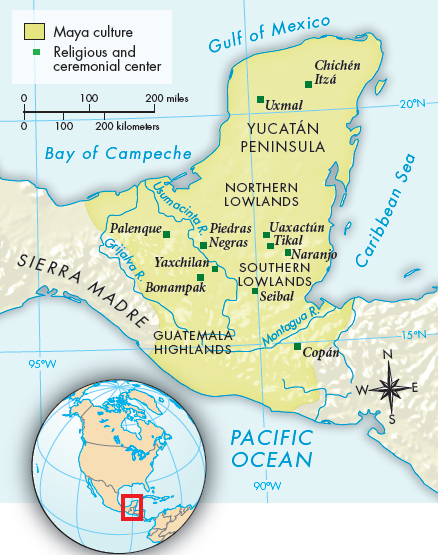Maya Agriculture and Trade
The Maya inhabited the highlands of Guatemala and the Yucatán peninsula in present-day Mexico and Belize. Their physical setting shaped two features of Maya society. First, the abundance of high-quality limestone allowed them to build monumental architecture. Second, limestone formations created deep natural wells called cenotes (say-NOH-tehs), which became critical sources of water in an often-arid environment. Cenotes were essential to farming and also became important religious and spiritual sites. The staple crop of the Maya was maize, often raised in small remote plots called milpas in combination with other food-stuffs, including beans, squash, chili peppers, some root crops, and fruit trees. They farmed on raised narrow rectangular plots that they built above the seasonally flooded low-lying land bordering rivers.

Palace Doorway Lintel at Yaxchilan, Mexico Lady Xoc, principal wife of King Shield-Jaguar, who holds a torch over her, pulls a thorn-lined rope through her tongue to sanctify with her blood the birth of a younger wife’s child — reflecting the importance of blood sacrifice in Maya culture. The elaborate headdresses and clothes of the couple show their royal status. (© The Trustees of the British Museum/Art Resource, NY)

MAP 11.4 The Maya World, 300–900C.E. The Maya built dozens of cities linked together in trading networks of roads and rivers. Only the largest of them are shown here.
The entire Maya region may have had as many as 14 million inhabitants. Sites like Uxmal, Uaxactún, Copán, Piedras Negras, Tikal, Palenque, and Chichén Itzá (Map 11.4) emerged as independent city-states, each ruled by a hereditary king. These cities produced polychrome pottery and featured altars, engraved pillars, masonry temples, palaces for nobles, pyramids where nobles were buried, and courts for ball games. The largest site, Tikal, may have had forty thousand people and served as a religious and ceremonial center. A hereditary nobility owned land, waged war, traded, exercised political power, and directed religious rituals. Artisans and scribes made up the social level below. Other residents were farmers, laborers, and slaves, the latter including prisoners of war.
At Maya markets, jade, obsidian, beads of red spiny oyster shell, lengths of cloth, and cacao beans — all in high demand in the Mesoamerican world — served as media of exchange. The extensive trade among Maya communities, plus a common language, promoted unity among the peoples of the region. Merchants traded beyond Maya regions, particularly with the Zapotecs of Monte Albán, in the Valley of Oaxaca, and with the Teotihuacanos of the central valley of Mexico. Since this long-distance trade played an important part in international relations, the merchants conducting it were high nobles or even members of the royal family.

